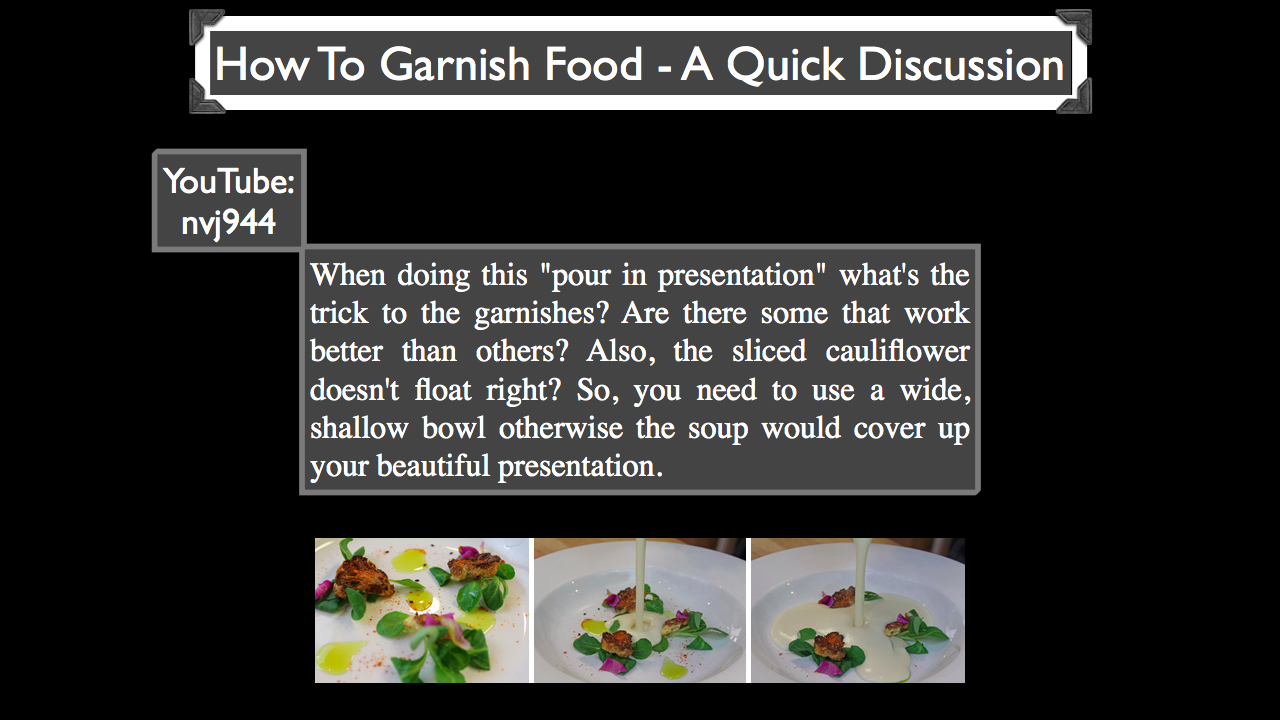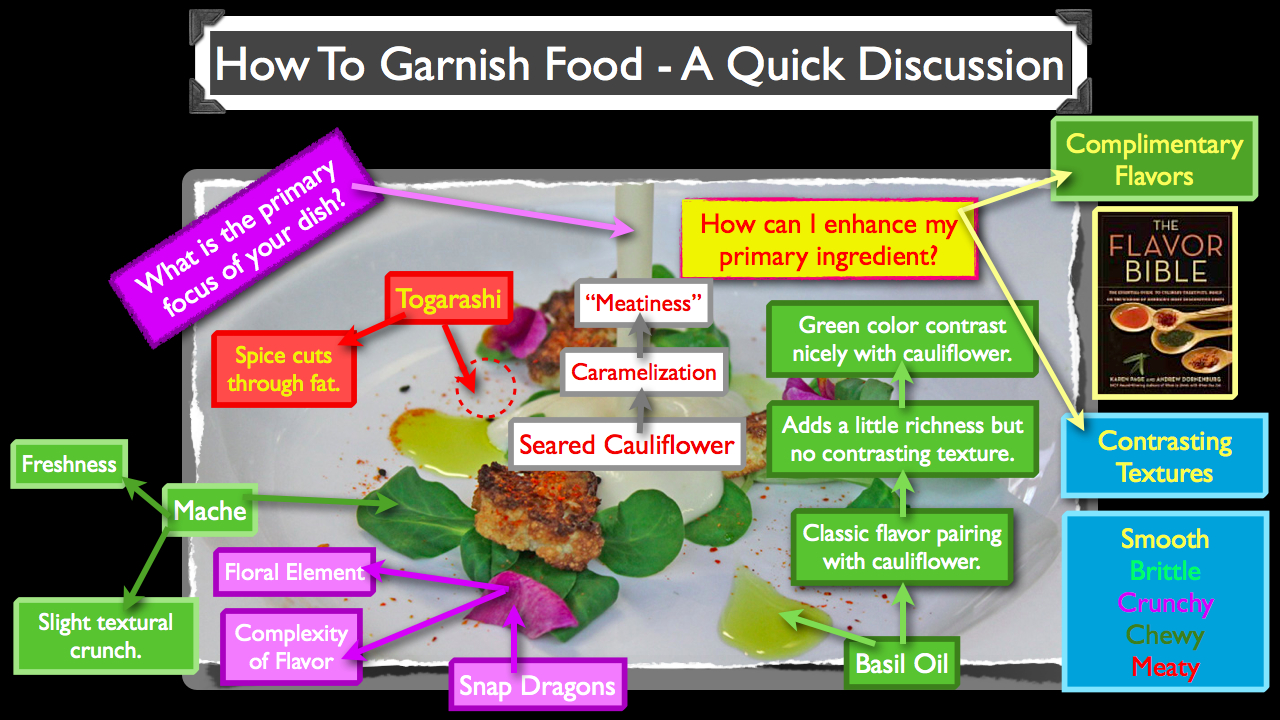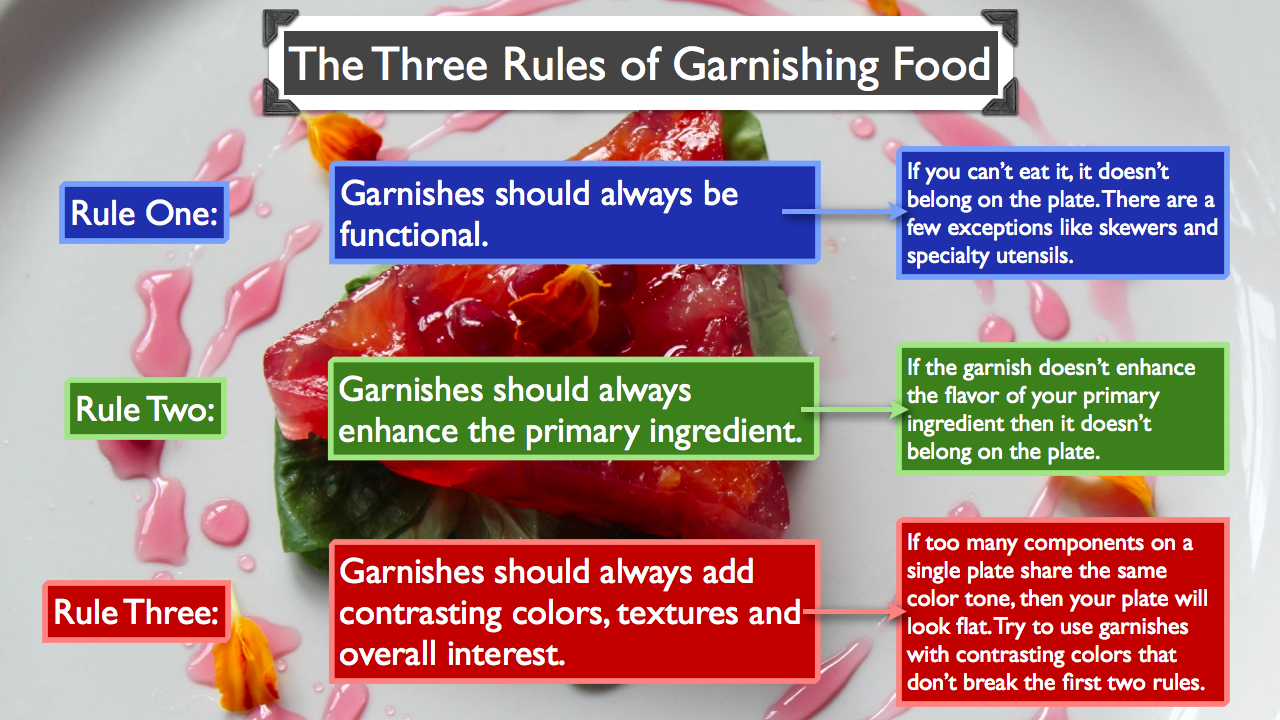In this video we discuss how to garnish food and some concepts to take into consideration when planing a completed dish. This video was inspired by a question posted by a YouTube viewer regarding our "Composed Cauliflower Soup" video.

YouTube User nvj944 asks: "When doing this 'pour in presentation' what's the trick to the garnishes? Are there some that work better than others. Also, the sliced cauliflower doesn't float right? So, you need to use a wide, shallow bowl otherwise the soup would cover up your beautiful presentation."
First, let's address the serving vessel and the issue with the soup covering the garnishes, which honestly isn't really an issue at all. Part of the "drama" that comes with serving a composed soup is the vanishing garnishes; a plate that was made purely for the pleasure one gets from looking at it, and then covered table side before being consumed.
As far as choosing appropriate garnishes, that's what this video discussion is really all about.

When choosing garnishes it is important to first identify the primary ingredient which all other garnishes will enhance. Once the primary ingredient is identified, start choosing garnishes that have complimentary flavors, colors and textures. In the example of the cauliflower soup above, the puree is a smooth consistency which can become quite one dimensional and boring after a few spoonfuls. When the same flavors and textures are tasted over and over, this quickly leads to "palate fatigue" and your primary ingredient becomes much less interesting bite after bite.
Properly chosen garnishes can prevent palate fatigue by introducing contrasting textures and complimentary flavors. When choosing complimentary flavors, take into consideration the overall texture and flavor profile of your primary ingredient. The pureed cauliflower soup contains fat in the form of cream and butter, which, while offering a nice mouth feel, fat is also known to coat the palate and deaden other flavors. This "deadening" effect can be countered by adding "brightness" in the form of acid (think vinegar, citrus, etc.), and/or by adding a little kick through the application of spice, in this case, togarashi.

Three Rules For Garnishing a Plate
- Garnishes should always be functional. If you can't eat it, it doesn't belong on the plate. There are a few exceptions like skewers and specialty utensils, but these exceptions are few and far between.
- Garnishes should always enhance the primary ingredient. If the garnish doesn't enhance the flavor of your primary ingredient then it doesn't belong on the plate.
- Garnishes should always add contrasting colors, textures and overall interest. If too many components on a single plate share the same color tone, then your plate will look flat. Try to use garnishes with contrasting colors and textures that don't break the first two rules.
This video also recommends the use of "The Flavor Bible" for inspiration in finding complimentary ingredients when coming up with a new dish.
The list can go on, but instead, what are your ideas? How can you take fresh pasta and turn it into your own unique dish? Let me know in the comments!
Related Resources
There are 2 Comments
A Bad Garnish & Plating Experience
I recently went to eat at a "fine dining" restaurant w/ my wife based on word-of-mouth recommendation. After being seated in an unclean dining room with initial less than minimally acceptable service, I decided to play it safe and order a simple beef fillet. It came plated on top of a bed of overly blanched broccoli and topped with a ridiculously large mound of fried, julienned potatoes and a jus. As a result, the steak took on the full flavor of the broccoli, and the julienned french fries, while edible, were ridiculous, cumbersome and soaked in jus. And, of course the brocolli tasted like steak.
What a horrible, lazy combination to begin with, and what the hell was the chef thinking by putting steak on a bed of brocolli? It was absolutely gross.
I really have a pet peeve with putting a protein on a bed of cooked vegetables just because it seems compulsory to do so. I don't know how many times I have had a completed dish served to me that is a protein on a bed of cooked vegetables without any thought as to how it will interact with the protein, like an afterthought. While it can work well, it often doesn't work at all.
What's so wrong with serving a nice vegetable creation on the side?
